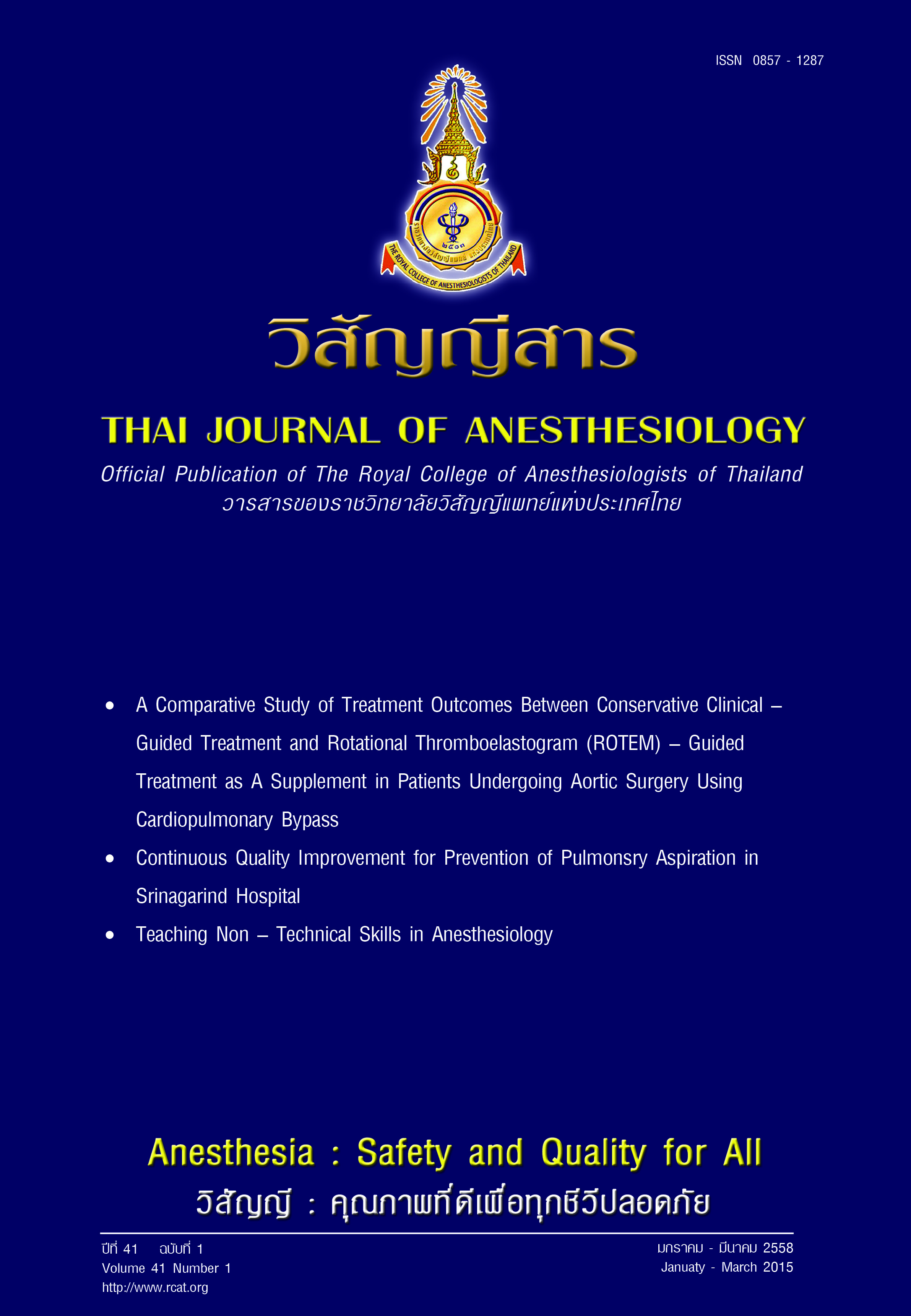Continuous Quality Improvement for Prevention of Pulmonary Aspiration in Srinagarind Hospital
Main Article Content
Abstract
Background and objective: Pulmonary aspiration is a serious anesthetic complication. The incidence in our hospital was 7.6:10,000. Our department developed and implemented a clinical practice guideline (CPG) for prevention of pulmonary aspiration in July 2010. The purpose of our study is to evaluate and enhance the implemented CPG for continuous quality improvement.
Methods: This was a retrospective, descriptive study. We reviewed every case which received anesthetic service in Srinagarind Hospital for perioperative pulmonary aspiration after implementation of the CPG for prevention of pulmonary aspiration between July 2010 and June 2011. The incidence and causes were identified and explored.
Results: We found 17 cases of pulmonary aspiration from 28,005 cases. The incidence was 6.1:10,000. The first 3 causes were the personnel not following the CPG in the following actions in high risk patients: 1) prophylactic medication; 2) aspirating gastric content before induction; and 3) rapid sequence induction (RSI) with cricoids pressure.
Conclusions: The implementation of the CPG for prevention of pulmonary aspiration could reduce the incidence from 7.6:10,000 to 6.1:10,000 but aspiration still occurred. The cause was not the incompetence of the CPG but the disobedience of the personnel.
การพัฒนาคุณภาพอย่างต่อเนื่องเพื่อป้องกันการเกิด Pulmonary Aspiration ระหว่าง การให้ยาระงับความรู้สึกแบบทั่วไปในโรงพยาบาลศรีนครินทร์
บทนำ: การสำลักสิ่งที่อาเจียนเข้าปอด (Pulmonary aspiration) ระหว่างการให้ยาระงับความรู้สึกแบ บทั่วไป จัดเป็นหนึ่งในภาวะแทรกซ้อนที่ก่อให้เกิดอันตรายร้ายแรงต่อผู้ป่วย ในโรงพยาบาลศรีนครินทร์มี อุบัติการณ์ 7.6:10,000 เพื่อลดอุบัติการณ์ดังกล่าว ภาควิชาวิสัญญีได้จัดทำและประกาศใช้แนวทางป้องกันการ เกิดภาวะนี้ในเดือนกรกฎาคม พ.ศ. 2553 เพื่อเป็นการพัฒนาคุณภาพอย่างต่อเนื่อง จึงต้องมีการติดตามผลและ ทบทวนปรับปรุงแนวทางปฏิบัติดังกล่าว
วัตถุประสงค์: เพื่อติดตามผลและปรับปรุงแนวทางป้องกันฯ ที่ ประกาศใช้
วิธีการศึกษา: เป็นงานวิจัยเชิงพรรณนาย้อนหลัง โดยเก็บข้อมูลของผู้ป่วยทุกรายที่มารับบริการ ทางวิสัญญีในห้องผ่าตัด ห้องพักฟื้นและหอผู้ป่วย ในโรงพยาบาลศรีนครินทร์ คณะแพทยศาสตร์ มหาวิทยาลัย ขอนแก่น ในช่วงหลังประกาศใช้แนวทางป้องกันฯ ตั้งแต่เดือนกรกฎาคม 2553 ถึงเดือนมิถุนายน 2555 หา อุบัติการณ์การสำลักสิ่งที่อาเจียนเข้าปอด วิเคราะห์หาสาเหตุ และนำผลที่ได้มาปรับปรุงแนวทางป้องกันฯ ให้มีประสิทธิภาพยิ่งขึ้น
ผลการศึกษา: พบการสำลักสิ่งที่อาเจียนเข้าปอดในผู้ป่วย 17 ราย จากผู้ป่วยทั้งหมด 28,005 ราย คิดเป็นอุบัติการณ์ 6.1: 10,000 พบว่า 3 อันดับแรกของปัจจัยเสี่ยง ได้แก่ 1) การไม่ได้รับ prophylaxis medications 2) การไม่ได้ปฏิบัติ aspirating gastric content before induction 3) การไม่ได้ปฏิบัติ rapid sequence induction (RSI) with cricoid pressure
สรุป: การประกาศใช้แนวทางป้องกันฯ สามารถลดอุบัติการณ์การสำลัก สิ่งที่อาเจียนเข้าปอดลงจาก 7.3: 10,000 เหลือ 6.1: 10,000 (สาเหตุที่ยังทำให้เกิดอุบัติการณ์ไม่ได้เกิดจากความ บกพร่องของแนวทางป้องกันฯ แต่เกิดจากการละเลยไม่ปฏิบัติตามของบุคลากร)


